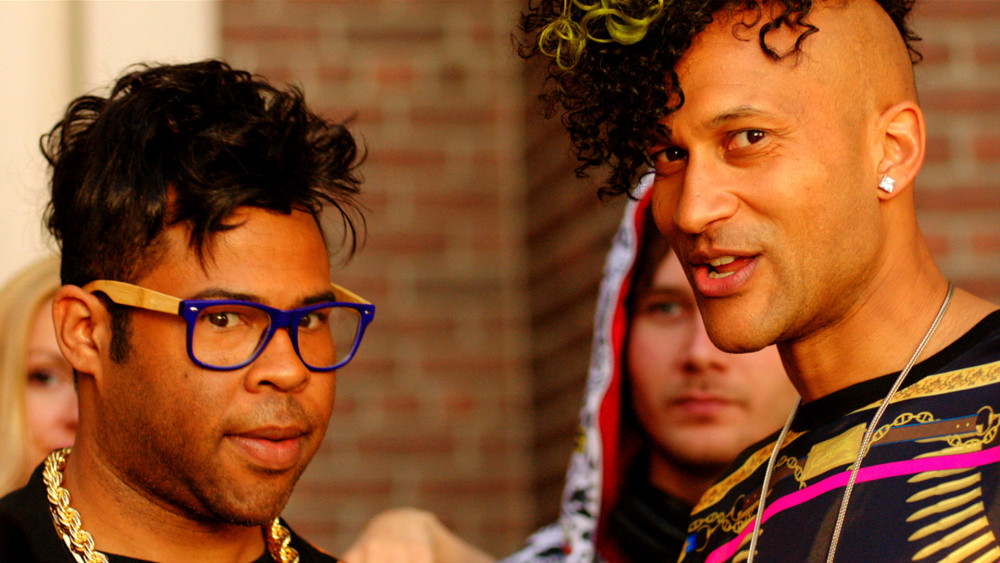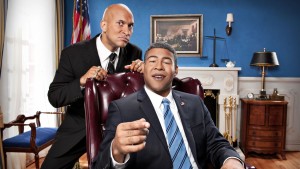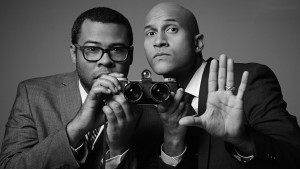Honest hour, I was not a day one “Key & Peele” fan. My first formal introduction into the world created by co-creators/stars Keegan-Michael Key, Jordan Peele, and director Peter Atencio was this YouTube clip:
The sketch opens at the 5th Annual Meeting of the Tallahassee Black Republicans. The opening speaker, played by Jordan Peele, is decrying the recent reelection of President Obama. All the visual and vocal cues associated with black male republicanism were in place: glasses, library, sweater and a preachy tone. The first joke comes as Peele’s character talks about how the Democrats should not have a monopoly on the black vote, citing that Republicans are a much more diverse group. At that moment, the camera pans up to his audience, a gathering comprised of 8-10 black men, all in their 40’s, wearing their delusion of inclusion under their suede jackets and hiked up jeans. It would have been easy enough to end the joke there, but Peele brings up Key’s character, who adds another layer of righteous indignation. The bit reaches its zenith when guest speaker Arthur Washington, played by Malcolm-Jamal Warner, comes to the podium. At this point, the words “pissed”, “monolith” and “diversity” have lost all practical meaning. There is a moment when Arthur is getting riled up and someone from the audience yells, “get those pants,” that dares you not to laugh. The charade ends with an interruption from the back of the room; someone’s white wife has come to pick them up. The room empties immediately.
For a show that produced over 50 episodes during its five year lifetime, it was the smallest sample size, but it was more than enough for me to go through the wormhole, marathon-watch the previous seasons while remaining current on the latest. “Key & Peele” officially signed off on Wednesday, October 9th, after earning accolades as real as a Peabody in 2014 and as intangible but equally impressive as a co-sign from the Obamas. Along the way, “Key & Peele” has been called everything from the rightful heir to “Chappelle’s Show”, to a hysterical weekly study on codeswitching.
“Key & Peele’s” brilliance lies partly in its critical lens going beyond the well-known and often preyed upon.
As someone who for a time carried around all three seasons of “Chappelle’s Show” on business trips, there is definitely some overlap in themes and pop culture importance between the two programs. However, there are also some distinct differences in both shows’ approach to sketch comedy. I think the quintessential difference between K&P and Chappelle was intention. “Chappelle’s Show” wanted to be (or maybe ended up being)a black outpost in the overwhelmingly white entertainment space. For three spectacular years, Chappelle and Neal Brennan aimed to explore the black urban experience in a way that had not been done in recent years. Some of our favorite “Chappelle’s Show” moments – The World Series of Dice, The Mad Real World, and Wu-Tang Financial, for example – are situated in a universe where black culture is the dominant culture. Key & Peele instead engage race in their comedy with a much broader emphasis on the impact of race on people and environments.
It would be fair to suggest that the differences that arise between the two shows are byproducts of their creators, as both Key & Peele are biracial, and the subject of identity has long been a part of their work. There is also something to be said about timing. “Chappelle’s Show” shut down the studio just before the meteoric rise of Barry Obama and well before the formation of the largest “us-only” lunch table in the world known as Black Twitter. Still, I would suggest that like all great art, “Key & Peele”, and “Chappelle’s Show” before it, not only drew inspiration from current events, it managed to deftly influence the conversation.
We can juxtapose Chappelle’s black universe to K&P’s black identity study by comparing “Black Bush” and “Obama and Luther”. “Black Bush” follows in the tradition of Richard Pryor’s First Black President sketch (1977) and others that satirically reimagined the leader of the free world as a black man. “Black Bush” works because it takes the unintended lunacy of the G.W. Bush years and raises the stakes through the addition of a different set of sensibilities. The sometimes aggressive, and other times jokingly aloof Black Bush winked at the double standard of acceptable behavior from POTUS. In a similar vein, “Key & Peele’s” “Obama and Luther” sketches discus the topic of reasonable presidential behavior.
The difference between the two is that when “Black Bush” was made, an actual black president was theoretical. With the arrival of President Obama, the days of imbuing black traits on a fictional form where gone. However, the internal thoughts of the first black president were fertile ground. Barack and his anger translator, Luther, tap into the duality of presenting an outward calm while masking inward frustration, a state of being for black people that has been described at length for centuries. From W.E.B. DuBois’ sociological theorizing on double consciousness to the poetic expression of Paul Laurence Dunbar’s We Wear the Mask. In every installment of “Obama and Luther”, the moment when Luther goes full tilt is inevitable, yet understandable, given the myriad of roadblocks, snares and insults President Obama has to endure. The punch line of Obama checking Luther, who then checks himself, resonates comedically, but also speaks to a level of necessary social awareness maintained by black people. If there is an imagined moment that blends comedy and cathartics better than President Obama and Luther doing the hammer dance after his re-election, I have not seen it.
“Key & Peele’s” brilliance lies partly in its critical lens going beyond the well-known and often preyed upon. One of the driving themes of the show was analyzing how two seemly disconnected people (often black) impact each other in different environments. “Nooice” is arguably one of the most well known K&P sketches, and it artfully depicts the competing interest dynamic that often arises among similarly defined people occupying the same space. If you have not seen it, the sketch features Jordan Peele’s character as an established hypeman for a group of breakdancers with Keegan-Michael Key’s character looking to join the group and turn the solo hype into a duet. Peele is not interested in a partnership, and sends Key packing. The pacing from introduction, to conflict to resolution is hilariously done. The message of their similarities being a bridge for their connection opposed to property to fight over is driven home without being sappy. When Key and Peele are in this mode of joke telling they highlight a strength that sets them apart from many of comedy shows. Neither Key nor Peele has to play the perpetual patsy. The humor of their jokes is not derived from dumping on a particular group or playing to trait stereotypes, but rather from looking at curious ways people twist themselves around situations both normal, and at times, completely abnormal. Skits like “Soul Foul” and “A Cappela” also showcase the art of status warfare and ask the audience to question what it means to fully represent your people.
The punch line of Obama checking Luther, who then checks himself, resonates comedically, but also speaks to a level of necessary social awareness maintained by black people.
While “Key & Peele” is a comedy show first, cultural artistry has always been asked to not only entertain, but also enlighten and inform. Over the course of their series, Key and Peele, sometimes subtly and other times more forcibly, explore important social issues of the day. The opening sketch of season three that aired in 2013, a year after the murder of Trayvon Martin, is entitled, “Hoodie”. The sketch opens on Jordan Peele dressed like your typical teenager in a black hoodie, jeans and a book bag. During his walk through a pristine neighborhood, Peele comes across a white family that immediately runs into their home upon the sight of him; next, a white man cutting his lawn stops and shakes his head in disgust; finally, a cop car patrolling the neighborhood pulls up alongside Peele. Sensing that he could be in danger, Peele puts on his hood and on the side of it is a picture of a blonde white boy. The police officer glances over to see what appears to be just a young white kid walking, and doesn’t think twice before continuing on his way. The imagery of a young black male having to put on whiteness in order to avoid a possible confrontation with law enforcement was a powerful statement about our current state of affairs.
In the same way, no topic was off limits to lampoon. Key and Peele used their show to have contemporary discussions abou homosexuality (Boxing Press Conference), media misconception (Black Ice), marriage equality (Gay Wedding Advice) and numerous other topics. As funny and socially in tune “Key & Peele” is, there is still one sketch that stood head and shoulders above the rest: “Negro Town”. First released in May 2015 before the start of their final season, its surprising nature took the web by storm. There simply are not enough superlatives to describe it. The true-to-life set up quickly gave way to the fantasy world we all know is not real and can’t possibly last, but the warmth of the colors, catchiness of the melody, the affirmation of the message, it envelopes you. Like many great experiences, it comes to abrupt close, back into the world as we know it. We are left disappointed that the dream wasn’t longer, or real, but grateful for the pleasant disruption. “Negro Town” is one of the few times we see Key and Peele’s construction of a black universe that is true to their perspective juxtaposed to the harsh reality of being black in the real world.
The last episode of “Key & Peele” was the ideal time to debut “Negro Town”. It was the flag plunged into the top of the mountain. As jarring as the top of the season announcement that this would be the last, it was understandable; the duo could do more shows, but really, what more could they achieve? Unlike many of its predecessors the stars of “Key & Peele” were not household names before they were given a platform they built a following. Back in January of 2012 few could have predicted that Keegan-Michael Key and Jordan Peele would be the comedy and cultural rockstars they became. The confluence of talent, drive and the boldness to not compromise their art took them from sideshow to the main attraction. Let’s be clear, the sketch comedy format is not new nor is there a lack of capable writers and performers. However, few programs had their finger on the pulse like “Key & Peele”.
For five stunning seasons they struck the balance between being political but not partisan, substantive without being preachy and current without trying to appear cool. On a weekly basis, “Key & Peele” gave us water cooler talk, inside jokes and material that asked us to question our own preconceived notions on a variety of topics. While I understand that the measuring stick for great art is not awards won but overall impact, I would be lying if said that I was not disappointed that “Key & Peele” was shutout again at the latest Emmys. “Key & Peele” was a place where a large swath of the nation and beyond saw themselves in funny and sometimes sobering ways, with no particular group as the regular butt of the joke. That was an incredible accomplishment that should be the new bar for excellence.
If there is a slight advantage that “Key & Peele” had over “Chappelle’s Show”, it’s that they ended on their own terms with a joke that might have been two seasons in the making. “Key & Peele” was simultaneously current, and forward thinking. If you have not watched, find the time to do so. If you have, say it with me: Nooice!



